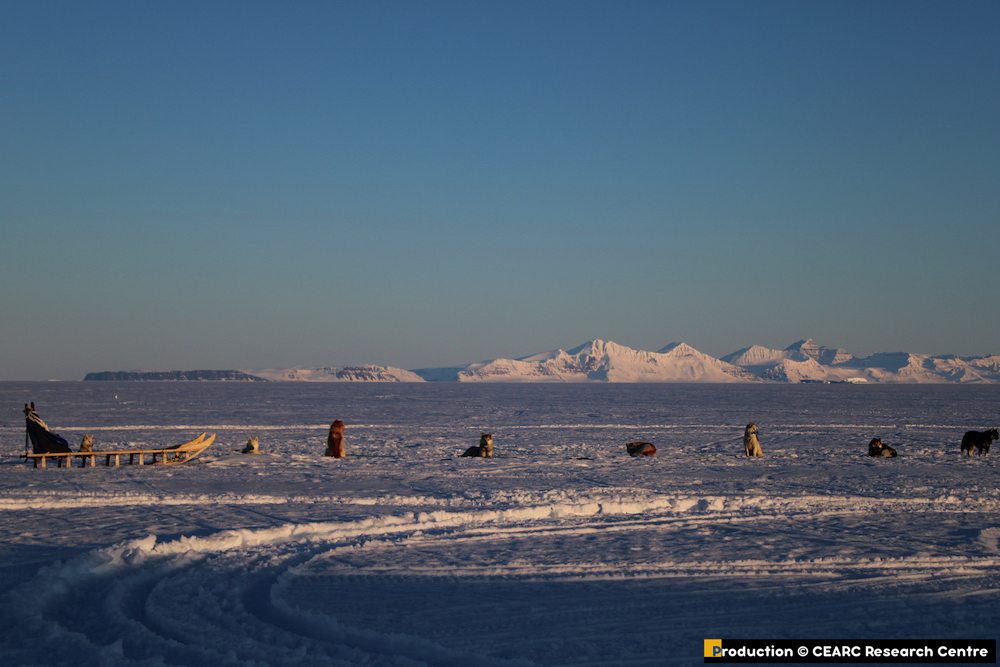Dogs at rest on the ice floe / Chiens au repos sur la banquise
May 2022. Every day I go walking on the ice floe, making my way around the village. After passing through the nerve center, around the store, I reach the bay at the frozen river, which is totally covered with ice and snow as well, and I walk around the village to the gas station. I love the sound of my footsteps on the snow of the ice floe, I love to stop and listen to the cry of the seagulls and the croaking of the big crows, when they are not chatting. And that's it, no other noise. I'm talking about those moments when the dogs are at rest, barely lifting an ear when they hear me passing by, those magical moments that are not interrupted by the sound of an engine.
I stop and observe. I look towards the other side of the fjord, and depending on the light, I see the shadows of an imaginary crowd of ice blocks of varying sizes that mark the newer and thinner part of the ice pack, a more unstable area, where it is more complicated to venture by snowmobile. It is quite fascinating to note the multitude of variations in the landscape. Always the same view, and yet never the same. The slightest shade of light generates a new impression. The tabular iceberg that serves as a giant stage for all this crowd also undergoes minute variations that make it multiple throughout the day. The evening light is probably the most spectacular because it brings a touch of color to this beauty, a touch of softness.
This is if my gaze shaves the ice floe. As soon as it rises a little, it is caught by these peaks culminating between 800 and 1900 m of altitude, connected by glaciers which appear like magnificent blankets of thick white velvet.
During the conversations, I understand that this year, the winter was obviously particularly cold, and it has been a long time since the entrance of the fjord has been frozen like this, more than 20 years. So, since the beginning of March, you have to go quite far, beyond Cape Tobin, to hunt seals that come to bask on the ice. This is also the reason why the bears are not very close to the village at the moment, they stay on the edge of the ice pack, to be able to feed themselves. It is quite interesting to note that the extent of the ice this year imposes longer trips for the hunters, and that it has become unusual for them.

by / par Jeanne Gherardi
Mai 2022. Tous les jours je vais marcher sur la banquise, en faisant mon tour du village. Après être passée par le centre névralgique, autour du magasin, je rejoins la baie au niveau de la rivière gelée et totalement recouverte de glace et de neige également, et je contourne le village jusqu’à la station-service. J’adore le bruit de mes pas sur la neige de la banquise, j’adore m’arrêter et écouter le cri des mouettes et le coassement des grands corbeaux, quand ils ne sont pas en train de papoter. Et c’est tout, pas d’autre bruit. Je parle de ces moments où les chiens sont au repos, lèvent à peine une oreille quand ils m’entendent passer à côté, de ces instants magiques qui ne sont pas interrompus pas un bruit de moteur.
Je m’arrête et j’observe. Je regarde en direction de l’autre côté du fjord, et selon la lumière, je vois les ombres d’une foule imaginaire constituée de blocs de glace de tailles variables qui marquent la partie plus récente et plus fine de la banquise, une zone plus instable, où il est plus compliqué de s’aventurer en motoneige. C’est assez fascinant de noter la multitude des variations du paysage. Toujours la même vue, et pourtant jamais identique. La moindre nuance lumineuse génère une impression nouvelle. L’iceberg tabulaire qui tient lieu de scène géante pour toute cette foule subit lui aussi d’infimes variations qui le rendent multiple au fil de la journée. La lumière du soir est sans doute celle qui est la plus spectaculaire car elle apporte une touche de couleur à cette beauté, une pointe de douceur.
Ça, c’est si mon regard rase la banquise. Dès qu’il se lève un peu, il est happé par ces sommets culminants entre 800 et 1900 m d’altitude, reliés par des glaciers qui apparaissent comme de magnifiques couvertures d’épais velours blanc.
Au fil des conversations, je comprends que cette année, l’hiver a visiblement été particulièrement froid, et cela fait très longtemps que l’entrée du fjord n’a pas été englacée ainsi, plus de 20 ans. Ainsi, depuis début mars, il faut aller assez loin, au-delà de Unnartoq/Cap Tobin pour chasser le phoque qui vient se prélasser sur la glace. C’est aussi la raison pour laquelle les ours ne sont pas très proches du village en ce moment, ils restent sur les limites de la banquise, pour pouvoir se nourrir. C’est assez intéressant de noter que l’ampleur de l’étendue de la glace cette année impose des trajets plus longs pour les chasseurs, et que c’est devenu inhabituel pour eux.



